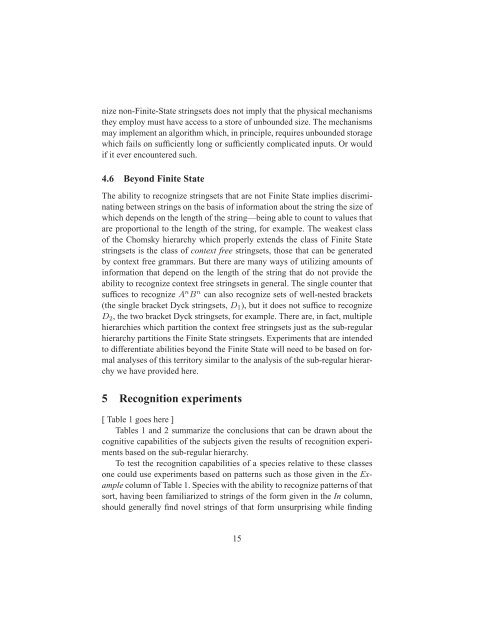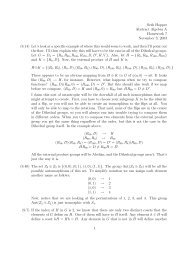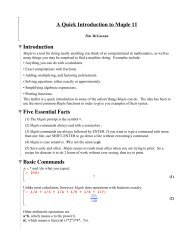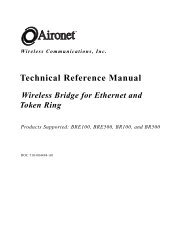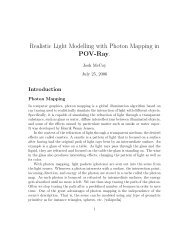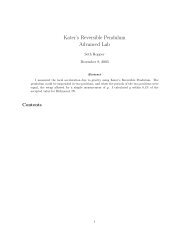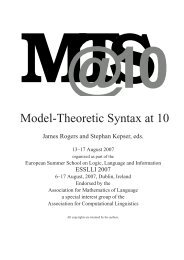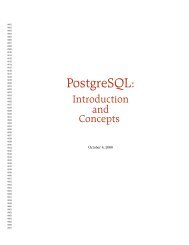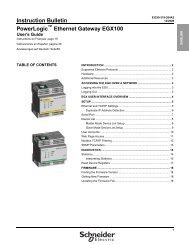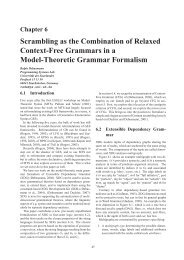The Use of Formal Language Theory in Studies of Artificial - CiteSeerX
The Use of Formal Language Theory in Studies of Artificial - CiteSeerX
The Use of Formal Language Theory in Studies of Artificial - CiteSeerX
Create successful ePaper yourself
Turn your PDF publications into a flip-book with our unique Google optimized e-Paper software.
nize non-F<strong>in</strong>ite-State str<strong>in</strong>gsets does not imply that the physical mechanismsthey employ must have access to a store <strong>of</strong> unbounded size. <strong>The</strong> mechanismsmay implement an algorithm which, <strong>in</strong> pr<strong>in</strong>ciple, requires unbounded storagewhich fails on sufficiently long or sufficiently complicated <strong>in</strong>puts. Or wouldif it ever encountered such.4.6 Beyond F<strong>in</strong>ite State<strong>The</strong> ability to recognize str<strong>in</strong>gsets that are not F<strong>in</strong>ite State implies discrim<strong>in</strong>at<strong>in</strong>gbetween str<strong>in</strong>gs on the basis <strong>of</strong> <strong>in</strong>formation about the str<strong>in</strong>g the size <strong>of</strong>which depends on the length <strong>of</strong> the str<strong>in</strong>g—be<strong>in</strong>g able to count to values thatare proportional to the length <strong>of</strong> the str<strong>in</strong>g, for example. <strong>The</strong> weakest class<strong>of</strong> the Chomsky hierarchy which properly extends the class <strong>of</strong> F<strong>in</strong>ite Statestr<strong>in</strong>gsets is the class <strong>of</strong> context free str<strong>in</strong>gsets, those that can be generatedby context free grammars. But there are many ways <strong>of</strong> utiliz<strong>in</strong>g amounts <strong>of</strong><strong>in</strong>formation that depend on the length <strong>of</strong> the str<strong>in</strong>g that do not provide theability to recognize context free str<strong>in</strong>gsets <strong>in</strong> general. <strong>The</strong> s<strong>in</strong>gle counter thatsuffices to recognize A n B n can also recognize sets <strong>of</strong> well-nested brackets(the s<strong>in</strong>gle bracket Dyck str<strong>in</strong>gsets, D 1 ), but it does not suffice to recognizeD 2 , the two bracket Dyck str<strong>in</strong>gsets, for example. <strong>The</strong>re are, <strong>in</strong> fact, multiplehierarchies which partition the context free str<strong>in</strong>gsets just as the sub-regularhierarchy partitions the F<strong>in</strong>ite State str<strong>in</strong>gsets. Experiments that are <strong>in</strong>tendedto differentiate abilities beyond the F<strong>in</strong>ite State will need to be based on formalanalyses <strong>of</strong> this territory similar to the analysis <strong>of</strong> the sub-regular hierarchywe have provided here.5 Recognition experiments[ Table 1 goes here ]Tables 1 and 2 summarize the conclusions that can be drawn about thecognitive capabilities <strong>of</strong> the subjects given the results <strong>of</strong> recognition experimentsbased on the sub-regular hierarchy.To test the recognition capabilities <strong>of</strong> a species relative to these classesone could use experiments based on patterns such as those given <strong>in</strong> the Examplecolumn <strong>of</strong> Table 1. Species with the ability to recognize patterns <strong>of</strong> thatsort, hav<strong>in</strong>g been familiarized to str<strong>in</strong>gs <strong>of</strong> the form given <strong>in</strong> the In column,should generally f<strong>in</strong>d novel str<strong>in</strong>gs <strong>of</strong> that form unsurpris<strong>in</strong>g while f<strong>in</strong>d<strong>in</strong>g15


